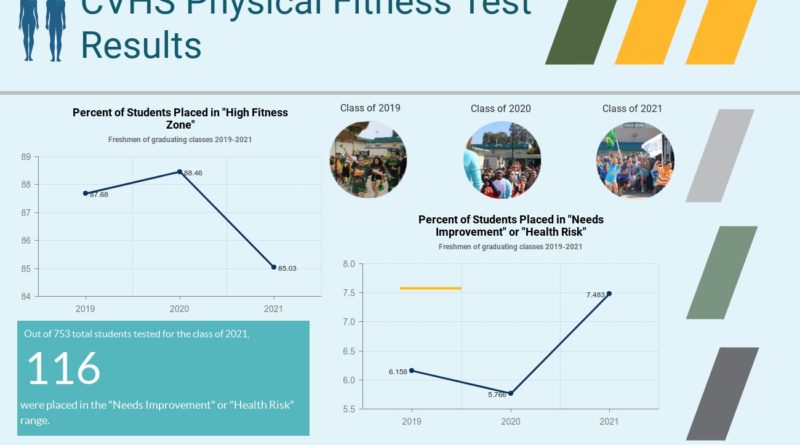Juniors top scores in fitness testing
CVHS juniors jumped into first, sophomores slumped into last and seniors slid into second, according to state physical fitness testing.
California Physical Fitness Testing evaluates students every year in grades five, seven and nine.
This test consists of five components of fitness which include aerobic capacity, abdominal strength, upper body strength, body composition (through height and weight), and flexibility. There are three important categories that show scores: the “healthy fitness zone,” “needs improvement” and “health risk” categories.
In CVHS testing completed in freshman years, the Class of 2020 (currently juniors) placed 88.5 percent of students in the “healthy fitness zone,” in an average of six fitness category scores.
Members of the Class of 2019, now seniors, scored 87.7 percent. The Class of 2021, now sophomores, had the lowest results in the healthy fitness category at 85 percent.
Over the course of three years, CVHS students’ results have relatively been all over the board. What variables play a role in this?
“The students’ ability to get into the healthy fitness zone matches up with the lack of participation,” said CVHS P.E. teacher Nicole Manley.
The physical test is important for the P.E. curriculum because it is a beneficial benchmark for the participants. It is a helpful evaluation for students to see where they are at in terms of progress. Many P.E. teachers in the department do baseline scores and start these in the first two weeks of school and asses the students throughout the school year to see the students overall improvement.
But students do not face consequences depending on their performance. The test does not count toward the students’ grades and this can be a major factor towards the lack of participation.
“It is not live or die” to the students, said Manley.
“I literally did the bare minimum just so my teacher would give me points for the day. I definitely think students would have worked harder if the test went towards our grade,” says sophomore Jessica Mulvihill.
“I guess I could have worked harder during the test but I just didn’t see a point since I wasn’t graded for any part of it,” said junior Hayden Matawaran.
Another reason behind more students not entering the healthy fitness zone could contribute to what students do outside of P.E.
“Lack of activity, lack of food choices… and technology plays a big role in these low numbers,” said Manley. The P.E. department is hoping to see an increase these testing scores with the new introduction of the Trojan Fit program.
Technology usage has skyrocketed over the years. This is a leading contributor to the decline in fitness within the freshmen P.E. classes, Manley believes.
Previously, students were allowed to bring their phones during class. This led to less participation. However, this year has changed a significantly because the P.E. department eliminated all phone use.
The participation from the class of 2022 has increased since the elimination of cell phones and the P.E. department has high hopes for improved, successful scores.
“We are hoping to see an increase in students placement in the healthy fitness zone,” said Manley.

